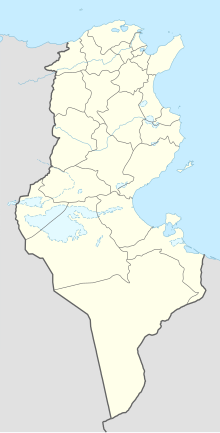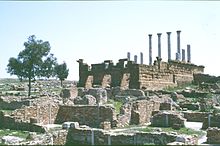Thuburbo Majus
Coordinates: 36 ° 24 '9.2 " N , 9 ° 54' 10.8" E
Thuburbo Majus is a ruin site from Roman times in what is now Tunisia .
geography
The excavation site is located 61 km southwest of Tunis near the village of El Fahs . The ruins are about 200 m above sea level on a slope above the Oued Miliane .
history
A Punic and later Numidian settlement is documented from the 5th century BC, but nothing is known about its history. The Romans laid down in 27 BC BC under Emperor Augustus a colony at the strategically favorable location, from which the neighboring mountainous region could be controlled, and granted it the rights of a municipality . Strategically located on the main trade route between Carthage and Hadrametum and wheat and wine of the place took rapid upswing and received 128 n. Chr. Under Hadrian the rank of civitas Between 150 and 250 reached the city flourished, whose wealth mainly on the Trade between inland and coastal towns was based. The population was estimated to be between 7,000 and 12,000 people.
In 188 Emperor Commodus officially granted the city the status of a colony called Colonia Julia Aurelia Commoda . Their importance declined towards the end of the 3rd century. Emperor Constantine tried to restore the city, which still had around 1,000 inhabitants. There was again an upswing in the city, now called Res Publica Felix Thuburbo Majus . Its importance declined under the vandals and the later invasion of Arab warriors, who spread Islam , to that of a village. The settlement was badly damaged by earthquakes. The French archaeologist Charles Tissot wrenched the site from oblivion in 1857.
The city was a bishopric. Four of his bishops are known:
- Sedatus, present at the Council of Carthage (256) Individual references:
- Faustus, present at the Council of Arles (314)
- Cyprianus, took part in the church conference of Carthage (411) with his competitor, the Donatist Rufinus
- Benenatus, banished by Hunerich (484).
The Catholic Church has a titular bishopric of the same name .
See also: Thuburbo Minus
Monuments
Capitol
The center of the city is the square forum with a side length of 55 m, which is surrounded by a three-sided portico of the Corinthian order . The column shafts are in Greek, from the island of Euboea derived marble made. The north side dominates the gods Jupiter , Juno and Minerva consecrated Capitol . The temple was built in 168 AD by order of the proconsul of Provincia Africa , Salbius Julianus. Four of the 10 pillars of the prostyle could be erected again: They are 8.50 m high and have a base diameter of 85 cm. In the cella there was a 7 m high Jupiter statue , of which only the head and one foot could be found. These, like other valuable finds, are now housed in the Bardo Museum in Tunis.
Mercury temple
A circular temple surrounded by eight columns on the southwest side of the forum was dedicated to the god Mercurius . The round floor plan, which is unusual for Roman buildings, shows the Punic-Numidian influence, which is also evident in the Temple of Baal in the south of the excavation site .
Thermal baths
There were two bathing establishments in Thuburbo Majus. The so-called winter thermal baths were a large complex consisting of 20 rooms that were entered through a portico with Corinthian columns. The frigidarium still shows remains of the once rich mosaic decoration .
The even larger summer thermal baths were located in a depression. Nevertheless, a 17 m deep well was needed to reach the water table. The frigidarium, which was also richly decorated, had three cold water basins and was decorated with statues of Aesculapius , Hercules , Mercury and Venus .
Palestra of the Petronians
Right next to the thermal baths are the remains of the Palästra , a large competition area surrounded by a portico. From him numerous marble columns are sandstone - capitals and part of the decorated with flowers and palmettos architrave received. According to an inscription, the complex was donated by Petronius Felix and his sons in 225. The well-known relief with two dancing maenads is among the rich furnishings in the Bardo Museum .
Wilhelmina F. Jashemski excavated the gardens here in the house of Bacchus and Ariadne .
Web links
literature
- Hans-Joachim Aubert: Tunisia . Kohlhammer Art and Travel Guide, Kohlhammer Verlag Stuttgart 1986, pp. 210-223. ISBN 3-17009231-6


